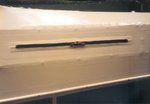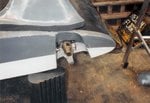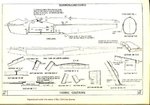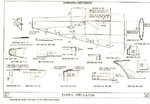I was reading a review on kit details today and there was mention about a certain simulated fabric "look" for the doped fabric covered control surfaces. Well, these have no texture at all. Once the fabric is properly finished, the warp and weave are completely filled and smooth as a countertop. Suffice it to say there is no "look" of fabric. If there is, then whoever did the job of recovering did it poorly. There will be the appearance of the material being slightly sunken with regard to the structure it's attached to and this is due to the stitching and rub strips being higher (over top of) the structure.
Navigation
Install the app
How to install the app on iOS
Follow along with the video below to see how to install our site as a web app on your home screen.
Note: This feature may not be available in some browsers.
More options
You are using an out of date browser. It may not display this or other websites correctly.
You should upgrade or use an alternative browser.
You should upgrade or use an alternative browser.
Fabric covered feathers
- Thread starter Sweb
- Start date
Ad: This forum contains affiliate links to products on Amazon and eBay. More information in Terms and rules
More options
Who Replied?Airframes
Benevolens Magister
At last! Someone who agrees with me! I see so many model reviews where it's stated the fabric texture is this, or that, when it shouldn't be there!! You're quite right Bill - if, on the real thing, the weave of the fabric can be seen or felt, then someone has done a bl**dy bad job!
I alwyas either sand off any fabric detail, or ensure it's obliterated by paint. Maybe some modellers just don't look when they have the opportunity of being close to the real thing (which goes for panel lines too!), but then, I've hd the advantage of a lifetime of being around aircraft.
I alwyas either sand off any fabric detail, or ensure it's obliterated by paint. Maybe some modellers just don't look when they have the opportunity of being close to the real thing (which goes for panel lines too!), but then, I've hd the advantage of a lifetime of being around aircraft.
hawkeye2an
Staff Sergeant
Amen, gentlemen. Preaching to the choir here. Most panel lines in 1/48 models would scale out to about 1/4 inch in width and I've seen a LOT of planes in my time and NONE had that kind of a gap unless the panel was partially open.
Fabric! A classic method of finishing the airplane but requires a special skill, to make a once very soft material called fabric into an airtight parts of the aircraft by first applying several layers of clear tautening dope lacquer onto the originally soft fabric normally with brush with sanding with or without water done between each application primary for giving the fabric a proper tension at the same time filling the fiber of the fabric so as to make it airtight and doing so make the appearance of the fabric into something like an opaque thin plastic sheet. By applying layers of normal pigmented lacquer enamel over the doped fabric surface will greatly enhace the quality and durability of the surface if the painting of the latter done properly.
Therefore my opinion that when re-producing the originally fabric covered surface on airplane models (kit) even in larger scale the surface should be smooth. Texture can be re-produced by applying flat paints and that is enough, sir.
Therefore my opinion that when re-producing the originally fabric covered surface on airplane models (kit) even in larger scale the surface should be smooth. Texture can be re-produced by applying flat paints and that is enough, sir.
Last edited:
FLYBOYJ
"THE GREAT GAZOO"
ppopsie nailed it folks. Also keep in mind that contrary to some modeling "experts", the paint and dope DOES chip in time, especially if there were flaws in the initial process.
Here are portions of Swordfish. A typical fabric covered finish. It was in 2000 when people there said they wants to use the Linen fabric instead of modern ones as long as supply lasts.
Attachments
Last edited:
N4521U
Colonel
oo oo, if Anyone evr gets the chance to do fabric covering JUMP at it. I did a two way trade with an air museum. I lettered their Short Solent, they got me in to the fabric section of the local A&P school. we cover, cut, repaired and painted wing sections. the school used to do the fabric repair of the museum planes as "subjects" in the classes. non airworthy repairs of non airworthy aircraft. I LUUUUUUVED it. I made my own wing tip cuz I was not getting a certification, just the experience. I will take a shot of the cut and repair..... woohoo Bill....... and you are correct, done properly it will have verrrrry little texture when finished. although the paint should be as thin as possible for weight and balance purposes. sea planes, and float planes use a little weep attachment at the very back underside to let out moisture. I will show that as well. I just luuuuved it mate.
hawkeye2an
Staff Sergeant
Here are portions of Swordfish. A typical fabric covered finish. It was in 2000 when people there said they wants to use the Linen fabric instead of modern ones as long as supply lasts.
GREAT SHOTS, thanks for sharing !!
FLYBOYJ
"THE GREAT GAZOO"
I like the new stuff (Stitts). A bit less time consuming.
Not just material but skills. Also please read this document. They say CB dope paint is no good since it keeps on shrinking for decades eventually to cause some deformation on the rebuilded planes. The older nitro-cellulose dope is better because once it dries and set, is more stable than the newer cellulose-butyrate dope.
http://www.awm.gov.au/events/conference/bigstuff/papers/treatment/nitrate.pdf
http://www.awm.gov.au/events/conference/bigstuff/papers/treatment/nitrate.pdf
FLYBOYJ
"THE GREAT GAZOO"
Not just material but skills. Also please read this document. They say CB dope paint is no good since it keeps on shrinking for decades eventually to cause some deformation on the rebuilded planes. The older nitro-cellulose dope is better because once it dries and set, is more stable than the newer cellulose-butyrate dope.
http://www.awm.gov.au/events/conference/bigstuff/papers/treatment/nitrate.pdf
I have issues with that document.
To use the older nitro-cellulose dope, you'll older types of fabric. That in it self is more susceptible to deterioration, especially mold, let alone the fire danger. The amount of shrinkage on the CB dope can be controlled, especially if it being used for a static aircraft and that's where I think the problem lies. These aircraft are not flying. There are no loads being placed on the rest of the fabric surface and that's one of the reasons why they are seeing this. The CB dope will shrink, but I believe in a flying aircraft the shrinkage is offset by the loads placed on the rest of the surface that allow growth or stretching of the fabric and will offset any shrinkage.
Last edited:
I think you nailed it. Airplanes are for flying not for displaying. Your reasoning makes sense to me greatly because I too have observed many of wooden/fabric covered aircraft mostly with CB/cotton finish in service for a dacade but in most cases they were almost without deformations to a degree losing airworthiness.
BTW actually I wrote that to re-produce the texture of fabric finish on the models, airbrushing the matt paint is enough. BUT I don't believe that is enough for building and finishing model of the Mosquito in 24th scale. I would rather re-producing the overrapping and/or the fabric tapes as shown on the pics I listed. In my opinion one of the problems on modeling the Mossie is that the real Mosquitoes I have seen in the museums are quite seemed (to me at least) like the assembled and well finished big plastic kit and were not very exiting.
If the kit have them expressed, then "I will withdraw my statement, General."
BTW actually I wrote that to re-produce the texture of fabric finish on the models, airbrushing the matt paint is enough. BUT I don't believe that is enough for building and finishing model of the Mosquito in 24th scale. I would rather re-producing the overrapping and/or the fabric tapes as shown on the pics I listed. In my opinion one of the problems on modeling the Mossie is that the real Mosquitoes I have seen in the museums are quite seemed (to me at least) like the assembled and well finished big plastic kit and were not very exiting.
If the kit have them expressed, then "I will withdraw my statement, General."
Attachments
Last edited:
FLYBOYJ
"THE GREAT GAZOO"
Users who are viewing this thread
Total: 1 (members: 0, guests: 1)






